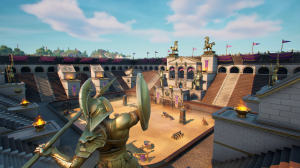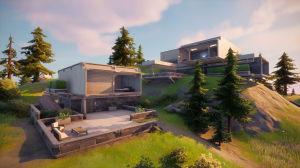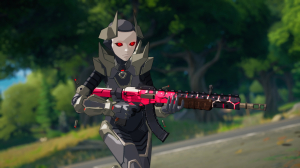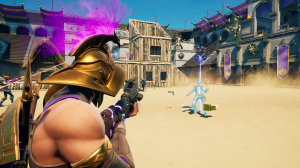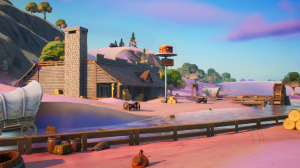Fortnite
Fortnite's lively cartoon universe delivers more excitement, diversity, and laughter than any other battle royale game. However, the steep learning curve of its intricate fort construction system and an expanding cache of gadgets and weaponry may induce early defeatism in rookies before they appreciate the brilliance of the game.
A standard in the battle royale genre, Fortnite allows 100 players, either solo, in pairs, or squads of four, to plummet from a party bus held beneath a dirigible set on a random course over the map. Landing on different parts of the map, they must quickly search for guns, shield potions, construction materials, and unique items. This quick stocking up is key to ensuring survival in the Fortnite world, as players need effective weapons for every encounter and enough resources to build shielding structures.
Originally developed for the relatively slow Save the World player versus environment mode, the building system also proves surprisingly fitting for Battle Royale. The top players are impressively adept at switching between tiles just as skating as Quake experts swap weapons, crafting mind-boggling towers, and switching out parts like doors, floors, or stairs. Despite being simple, these editing tools perfectly serve the fast pace of mouse and keyboard combat.
While the initial learning curve is quite daunting, once players invest time, assimilate new skills, learn to recreate keys, and get comfortable smashing everything around with their pickaxe, the building function becomes almost second nature. However, a formal tutorial or a practice arena would significantly help new players.
Ideal combat in Fortnite involves two players racing to hold the highest ground, building brick towers, and exchanging fire until ammunition runs out. This architectural jazz combat becomes the new norm. Nonetheless, it isn’t a guaranteed win. The game gives players plenty of tools and strategies to navigate themselves out of sticky situations, making Fortnite's battle royale combat one of the most unpredictable and exhilarating in the genre.
Fierce build-offs occur once or twice per match, with the remainder of the time spent searching for resources in deserted prisons and flooded forests. Fortnite's impressively compact map ensures frequent player encounters, with hot spots like Tilted Towers and Pleasant Park promising high risks and rewards.
Conclusion
In conclusion, Fortnite doesn’t just stick to the typical battle royale formula but adds its own creative twist to it. It gives its players the tools and freedom to innovate and strategize, making each game a unique experience. While the learning curve can be quite steep, putting in the time to understand the mechanics of the game is rewarding in itself. Despite its challenges, Fortnite offers an unpredictable, exciting, and complex battle royale combat that sets itself apart in the genre. There is always the anticipation of what the developers will think of next, setting the stage for continuous fun and surprising gameplay twists.
- **Innovative Gameplay:** Fortnite offers a unique approach to the battle royale genre with its incorporation of building mechanics alongside traditional combat
- **Frequent Updates:** The game regularly provides new content, such as weapon updates, map changes, and themed events, which keeps the gameplay fresh and engaging
- **Free to Play:** Fortnite is a free-to-play game that allows anyone with a suitable device to enjoy its core gameplay
- **Large Player Base:** The expansive player base ensures the availability of matches at practically all times
- **No Formal Tutorials:** Despite its successful implementation, the lack of tutorial or practice mode for the building mechanics can overwhelm newcomers
- **Performance Issues:** Some players may experience performance problems, depending on their device's hardware capabilities
- **Monetization Model:** Whilst free to play, the game does rely heavily on in-game purchases, which can lead to a sense of pay-to-win
- **Limited Map Variation:** With only a single map that undergoes changes, there may be limited map variety, which could lead to repetitive gameplay

